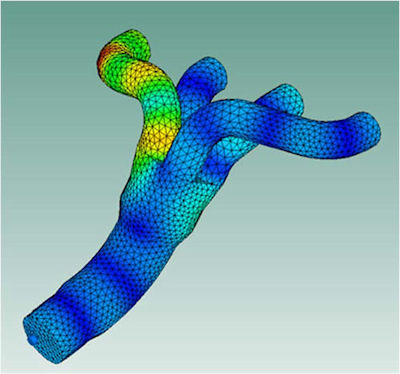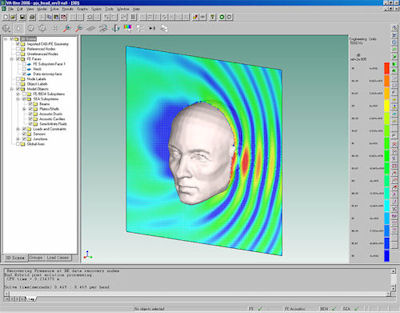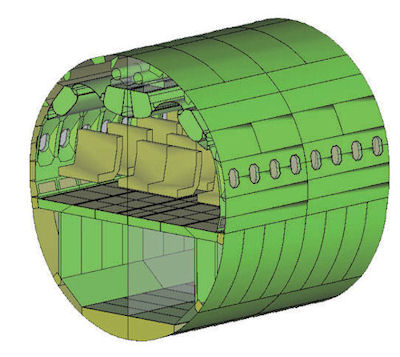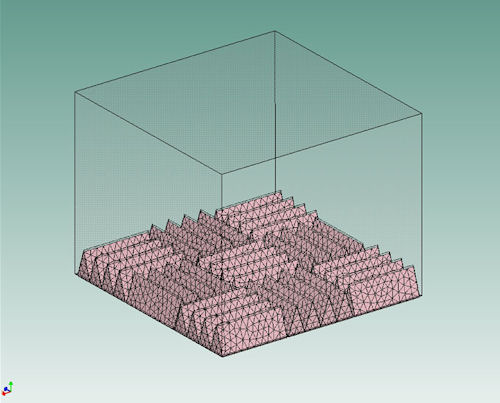Latest News
February 12, 2014
By Anthony J. Lockwood
ESI Group (Paris) announces this month the latest release of its VA One vibro-acoustic simulation software, VA One 2014.0. Key new capabilities include speech clarity assessments and support for engine run-ups and similar multiple load cases. This latest release builds off the previous version, which offered enhancements to take into account hybrid area junctions between FE (finite element) cavities and SEA (statistical energy analysis) panels.
 VA One’s Acoustic Finite Element module can be used to create models of enclosed acoustic cavities at low frequencies. Image courtesy of ESI Group. |
VA One can be used to predict and resolve potential noise and vibration problems upfront in the development process. According to ESI Group, the solution enables the simulation of noise and vibration across the full frequency range by seamlessly combining key vibro-acoustic modeling methods, including finite element methods (FEM), boundary elements methods (BEM) and SEA methods in a single model. The company adds that the simulation suite allows engineers to get a precise idea of a product’s future vibro-acoustic performance by setting up interior or exterior acoustic models coupled with a vibrating structure experiencing various types of excitations.
 With VA One’s Acoustic Boundary Element Module, engineers can create models of fluid loading, scattering, radiation and transmission of sound at low frequencies. Image courtesy of ESI Group. |
VA One is described as enabling the coupling of statistical and deterministic modeling methods in a hybrid manner. This, says ESI Group, provides engineers the flexibility to make models as detailed or as simple as needed. The developer adds that system level noise and vibration models can be created in hours and solutions derived in seconds, even on a laptop.
The previous update of VA One debuted functionality to take into account hybrid area junctions between FE cavities and SEA panels. This capability, says the company, enables engineers to improve the characterization of small cavities, such as those encountered while developing home appliances, cabins or small vehicles. The company adds that this ability also enables engineers to couple BEM and FE cavities, which allows simulations of the vibro-acoustic performance of complex heating, ventilation and air-conditioning (HVAC) ducts.
 The Statistical Energy Analysis (SEA) module of VA One. Image courtesy of ESI Group. |
VA One can also calculate and plot transmission loss for all sources and receivers, including BEM, semi-infinite fluid and diffuse acoustic field (DAF). This, the company says, is beneficial for users who need to model acoustic transmission loss through walls and panels.
The new Speech Clarity module introduced in the 2014.0 version of VA One provides functionality for computing and visualizing STI (speech transmission index) and RASTI (rapid speech transmission index) for speech clarity assessments. With it engineers can, for example, determine PA system intelligibility for certification purposes in trains and aircraft and for passenger comfort purposes for automotive vehicles. VA One 2014.0’s new support for engine run-ups and other multiple load cases enables engineers to assess the radiation profile of a powertrain under operational loads, including varying revolutions per minute and varying throttle position.
 Poro-elastic material modeling in VA One is based on a FEM approach. Image courtesy of ESI Group. |
Other enhancements in VA One 2014.0 include increased solver speed, new source types and new functions that ease model building. Recent enhancements also include new functionalities that are said to improve user experience and workflow integration. Users can customize their toolbars to map their design process, which can facilitate handovers between different teams. VA One’s Developer’s Kit has been updated to support Python 3, allowing for the creation of dialogs within VA One’s environment.
VA One embraces core modules of acoustic BEM, acoustic FE, fast multi-pole methods, poro-elastic materials, SEA and structural FE. Capabilities provided by advanced extension modules include aero-vibro-acoustics, CAD import, design optimization, grid solvers, scripting, shock, and variance.
“The latest version of VA One covers the full spectrum of frequencies with great flexibility, delivering precise vibro-acoustic simulation results,” said Sebastien Chaigne, vibro-acoustic solution director at ESI Group in a press statement.
For more information on VA One, visit ESI Group.
Learn more about VA One’s core and extension modules.
Access technical papers on vibro-acoustics.
Read how engineering companies use VA One.
Sign up for an upcoming webinar on what’s new in VA One 2014.0.
Sources: Press materials received from the company and additional information gleaned from the company’s website.
Subscribe to our FREE magazine, FREE email newsletters or both!
Latest News
About the Author
Anthony J. Lockwood is Digital Engineering’s founding editor. He is now retired. Contact him via [email protected].
Follow DE





